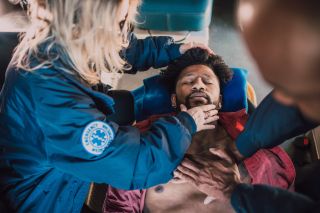Near-Death Experiences
Dying People May Remain Conscious an Hour After Flatlining
40 percent of patients show lucid brain activity during CPR.
Updated September 26, 2023 Reviewed by Devon Frye
Key points
- Researchers tracked electrical activity in the brains of patients in cardiac arrest.
- Forty percent of patients showed brain activity consistent with consciousness, even 60 minutes into CPR.
- Thirty-nine percent of survivors recalled aspects of their treatment or transcendent experiences of death.

We normally consider someone dead when their heart stops beating, but new research has shown that people undergoing CPR may continue to have bursts of consciousness for up to an hour after their heartbeats flatline.
Teams at 25 hospitals in the United States, United Kingdom, and Bulgaria collaborated on the study, published this month in the journal Resuscitation. Over the course of two years, they tracked 567 patients who experienced in-hospital cardiac arrest.
Researchers were alerted via pager when a hospitalized patient’s heart stopped. While medical staff performed CPR, the research team tested the patient for visual and auditory awareness and, if CPR went on long enough, set up equipment to measure electrical activity and oxygen saturation in the patient’s brain.
Forty percent of the patients who received brain monitoring showed brain activity consistent with consciousness, sometimes as late as 60 minutes into CPR. Electroencephalogram (EEG) readings registered spikes in the gamma, delta, theta, alpha, and beta waves associated with higher mental function despite significant oxygen deprivation to the brain.
Of the 53 patients who survived their ordeal, only 28 were well enough to describe what they experienced while they were in cardiac arrest and, to all intents and purposes, dead. Although none of them had shown external signs of consciousness during CPR, 39 percent reported memories of the event.
Researchers divided these memories into four categories:
- Emergence From Coma During CPR
- Emergence From Coma in the Post-Resuscitation Period
- Dreams and Dream-Like Experiences
- Recalled Experience of Death
One study subject, for instance, remembered doctors attaching electrodes to his chest and shocking him. According to his medical chart, he really had been shocked during resuscitation. Another subject claimed he was able to see and hear the doctors while they were treating him.
Six survivors described transcendent near-death experiences, like hearing their deceased grandmother telling them they needed to go back or leaving their bodies to watch what was happening to them from outside themselves.
To supplement their findings from the in-hospital study, researchers interviewed 126 other survivors of cardiac arrest and discovered one more category of experience: frightening delusions based on actual medical events. One interviewee saw the doctors resuscitating her as monsters tearing at her body, another believed the sting of an IV line meant they were burning in hell. Both had some awareness of what was really going on around them, but their minds embellished those events in fanciful ways.
"These experiences provide a glimpse into a real, yet little understood dimension of human consciousness that becomes uncovered with death,” says senior study author Dr. Sam Parnia, director of critical care and resuscitation research at NYU Langone. “This is the first large study to show that these recollections and brain wave changes may be signs of universal, shared elements of so-called near-death experiences."
Parnia and his co-authors hypothesize that the process of dying may cause the brain to release its usual restraints, explaining why people who’ve returned from the brink of death sometimes report a sudden mental clarity or the ability to review all their memories from birth to death.
The study, however, is not without limitations.
Because the majority of subjects died and researchers didn’t get brain readings from everyone, they were unable to match specific evidence of brain activity during cardiac arrest with the survivors who reported remembering the experience. Without that corroboration, the study can only conclude that patients had brain activity consistent with consciousness, not that they really were conscious.
The distinction between dream-like experiences and recalled experiences of death may also be more subjective than objective. After all, would we understand visions of late loved ones or the feeling of returning to a place that felt like home as experiences of death if it weren’t for popular ideas about the afterlife?
The team’s work, though, provides helpful information for physicians. Until now, less than 1 percent of cardiac arrest patients have been presumed to be aware of CPR. That figure was based on external signs that medical staff could observe, like movement and groaning. This study suggests that, from the perspective of patients, the figure may be more like 7 percent.
Patients’ conscious experiences during cardiac arrest may also play a role in their psychological well-being after resuscitation. Those who have a transcendental experience may emerge with a more positive outlook on life, while those who are conscious of pain may be more susceptible to post-traumatic stress disorder. This could add to the arguments in favor of sedating patients during CPR.
What Parnia wants people to take away from the study is that we experience something special at the moment of death. His team compared brain scans from this study to those of patients suffering hallucinations and found they are distinctly different.
“These electrical signals are not being produced as a trick of a dying brain,” he says. “These are a real experience that emerges with death.”
Facebook/LinkedIn image: Tyler Olson/Shutterstock




